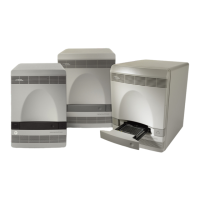DRAFT
September 25, 2007 1:07 am, 4376782_Get_Started.fm
Chapter 1 Get Started
About the StepOne
™
and StepOnePlus
™
Systems
3
Applied Biosystems StepOne
™
and StepOnePlus
™
Real-Time PCR Systems
Installation, Networking, and Maintenance Guide
CONFIDENTIAL — For AB Internal Use Only. Do Not Distribute.
Notes
About Data
Collection
The StepOne
™
and StepOnePlus
™
systems collect raw fluorescence data at different
points during a PCR, depending on the type of run that the instruments perform:
Regardless of the run type, a data collection point or read on the StepOne
™
or
StepOnePlus
™
instrument consists of three phases:
1. Excitation – The instrument illuminates all wells of the reaction plate within the
instrument, exciting the fluorophores in each reaction.
2. Emission – The instrument optics collect the residual fluorescence emitted from the
wells of the reaction plate. The resulting image collected by the device consists only
of light that corresponds to the range of emission wavelengths.
3. Collection – The instrument assembles a digital representation of the residual
fluorescence collected over a fixed time interval. The StepOne
™
software stores the
raw fluorescent image for analysis.
After a run, the StepOne
™
software uses calibration data (spatial, dye, and background)
to determine the location and intensity of the fluorescent signals in each read, the dye
associated with each fluorescent signal, and the significance of the signal.
Run Type Data Collection Point
Real-time runs Standard curve The instrument collects data following each
extension step of the PCR.
Relative standard curve
Comparative C
T
(∆∆C
T
)
Post-PCR
(endpoint) runs
Genotyping The instrument collects data:
• Before the PCR (For presence/absence
experiments, data collection before the PCR is
optional, but recommended.)
• (Optional) During the PCR. The instrument can
collect data during the run (real-time);
collecting data during the run can be helpful
for troubleshooting.
•After the PCR
Presence/absence
